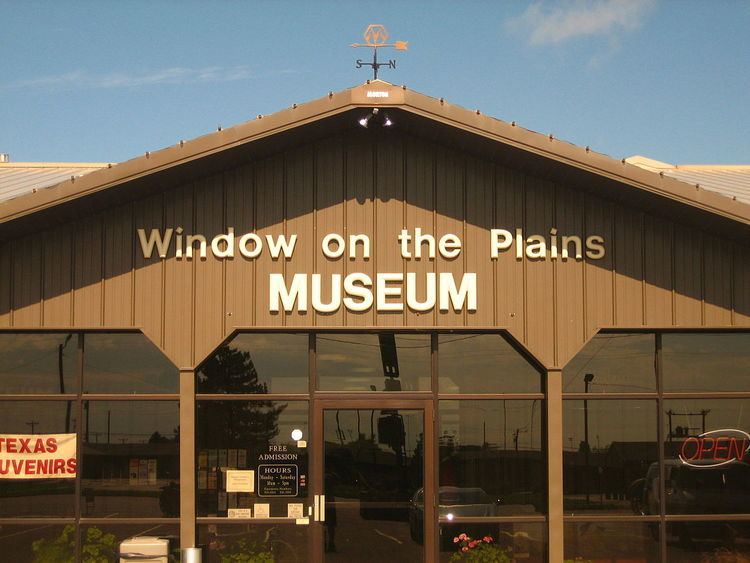Phone +1 806-935-3113 | ||
 | ||
Address 1820 S Dumas Ave, Dumas, TX 79029, USA Hours Open today · 10AM–5PMTuesday10AM–5PMWednesday10AM–5PMThursday10AM–5PMFriday10AM–5PMSaturday10AM–5PMSundayClosedMonday10AM–5PMSuggest an edit Similar Muleshoe Heritage Center, Lake Meredith Aquatic a, Carson County Square H, Pioneer West Museum, Floyd County Historical | ||
Our town dumas a look into the window on the plains museum
Window on the Plains Museum offers displays of ranching, farming, industrial, business, and family life exhibits of the Texas Panhandle during the late 19th and 20th centuries. It is located in Dumas, the seat of Moore County, at 1820 South Dumas Avenue on the common United States Highways 287 and 87. Dumas is approximately fifty miles north of Amarillo.
Contents
- Our town dumas a look into the window on the plains museum
- Local history
- List of exhibits and photographs
- References
Originally housed in the ballroom of the landmark Sneed Hotel and first known as the Moore County Historical Museum, the facility was dedicated on Bicentennial Day, July 4, 1976. It was relocated in 2001 to a modern building on a 10-acre (40,000 m2) tract in southwest Dumas and renamed "Window on the Plains." The facility also houses a research and archives center, and the Moore County Art Association is located next door.
The origin of the museum dates to January 1976, when representatives of the Moore County Historical Commission, the art association, and the Bicentennial Committee met to consider the establishment of a county museum. Collier Phillips, then president of the historical commission, was elected temporary chairman. A steering committee met with the county commissioners in February to seek permission to use the first floor of the hotel, now the Lew Haile Annex. The building had been donated to the county by Elizabeth Sneed Pool Robinette. The commissioners agreed to the proposal, work soon began on remodeling, building exhibit areas, acquiring and placing artifacts, and documenting records. Some fifty-two persons donated more than five thousand hours of labor, having completed the task in time for the formal dedication on July 4.
Local history
The museum contains a section on the local history of Dumas and Moore County. The origin of the city dates to 1891 when it was laid out by the Panhandle Townsite Company, headed by Louis Dumas (April 16, 1856—January 5, 1923), originally from Sister Grove near Dallas. Dumas and his wife, Florence (November 17, 1861—June 9, 1927), originally from Pilot Point in Denton County, were living near Dallas, when they lost a daughter, Johnnie (1881–1888). Dumas came to Moore County, while his grief-stricken wife stayed behind for a time before she joined her husband. After a blizzard again devastated Dumas in 1895, the couple returned to Sherman, the seat of Grayson County, where they died four years apart during the 1920s. Dumas hence lived only about seven years in the Panhandle city which bears his name.
During the 1880s, a drift fence of barbed wire was built to hold back cattle from Oklahoma, Colorado, and Kansas from crossing into the Texas Panhandle during blizzards. It was strung along the northern boundary of each ranch. The fence extended for two hundred miles in Texas, with a gate every three miles. In 1889, Texas passed a law prohibiting fencing of public property, and the fence was removed in 1890. It had been particularly disastrous for the cattle in 1887, when they were unable to head south for greener pastures during a blizzard.
Moore County is named for Commodore Edwin Ward Moore of the Texas Navy during the Republic of Texas and a friend of Robert E. Lee. Dumas became the county seat in 1892. In 1893, Louis Dumas donated land for the Moore County Courthouse, which was completed the following year at a cost of $6536. The original courthouse was replaced in the 1930s and still serves the county. The first state bank was established in Dumas in 1908. In time, it became the First National Bank of Amarillo, is now a branch of Bank of America.
Oil was found in Moore County in 1927. On July 29, 1956, eighteen, mostly volunteer, firefighters died while trying to extinguish a blaze at the Shamrock Refinery in Dumas, now owned by Valero Energy Corporation. Ken Floyd and Gabriel Horn prepared a documentary on the fire and the heroic efforts of the lost. There is also a monument at the Moore County Courthouse honoring the firefighters.
Lew Haile (April 25, 1878—March 19, 1961), for whom the county annex building is named, was a Moore County commissioner from 1910 to 1952, the longest tenure thus far for such a local official in Texas. Noel McDade (1882–1979), the first Dumas mayor (1930–1935) served as the Moore County administrative judge from 1935–1945. He was posthumously named "Citizen of the Century" in 1992.
List of exhibits and photographs
Museum exhibits include the following:
There is a large windmill and other exhibits outside the museum. Volunteers known as "Windmillers" help with various tasks about the facility, including welcomng guests. Museum hours are daily except Sundays from 10 a.m. to 5 p.m. There is no admission charge, but donations are welcome.
